“Well,” Dave said, letting out a deep sigh. “This has to be one of the biggest letdowns of my life.”
I nodded in quiet disappointment as I stared out at the bleak scene ahead of me. Instead of a snow-covered paradise, I was standing in what felt like a construction site full of rubble, with piles of rocks and exposed cables forming a backdrop against the commotion. I watched in dismay as staff at the Jigokudani Monkey Park threw food at the agitated macaques until they began to screech and fight on the damp mud.
This was one of the worst animal encounters I’d ever experienced.
Moments earlier, I had been bounding up the side of a mountain, singing to Dave about how one of my greatest travel dreams was about to realised. Brimming with so much joy that I could barely see.
I couldn’t believe I had got it so wrong.
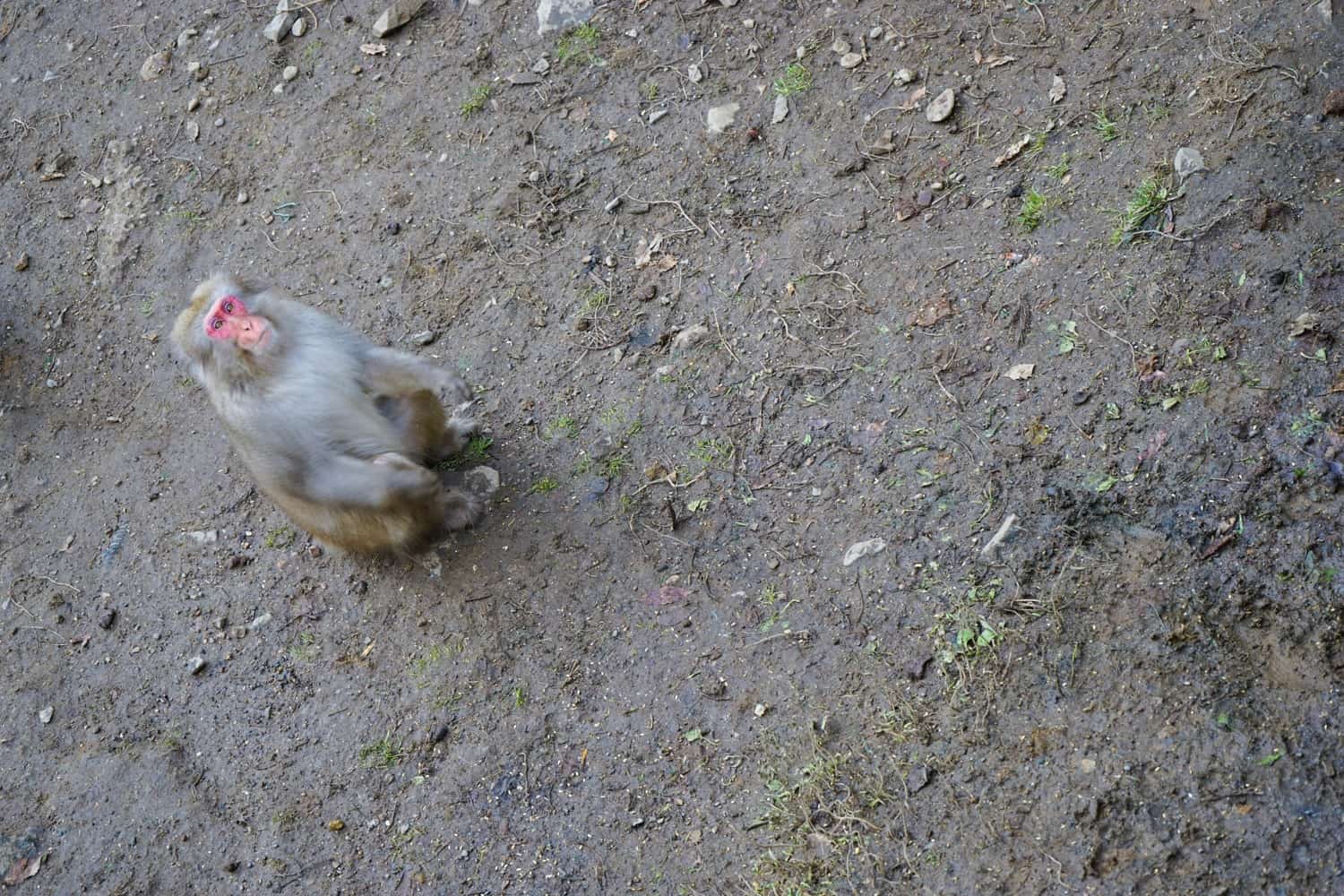
Jigokudani Monkey Park was founded by Sogo Hara in 1964 in an attempt to keep local macaques from harm.
Monkeys have lived in this area of Japan for a long time, but sixty years ago, their home in the forest was threatened. Trees were being cut down to build ski lifts for resorts, and as the monkeys’ habitat began to shrink, they travelled towards Jigokudani, otherwise known as the Valley of Hell.
Why such a dramatic name? This area of the country is full of mountains and volcanic activity, which means that in the winter, you can witness huge plumes of steam emanating from the hot springs that pool around this region.
As the monkeys moved closer to humans, they found themselves within a short distance of several farms. Suddenly, food was in plentiful supply, and the macaques were all about stealing the farmer’s apples. These farmers, unsurprisingly disgruntled, went on to petition the government about the situation, and were granted permission to kill the monkeys in order to protect their land.
When Sogo Hara found out about this, he created Jigokudani Monkey Park to keep the monkeys from harm. For months on end, he’d place apples in a nearby valley beside a hot spring, until eventually, the monkeys learned to stick around and avoid the farmland they’d been tearing apart.
And as for the whole bathing in an onsen thing? At some point, the apples in the valley began to fall into a nearby hot spring, and the monkeys started taking a dip into the water to fish them out. Macaques had not, until this point, ever been observed in onsens, but it turned out they kind of liked being warm in the winter.
And so a tourist attraction was born.
Here’s what I was expecting it to be like, based on the photos I’d seen online.
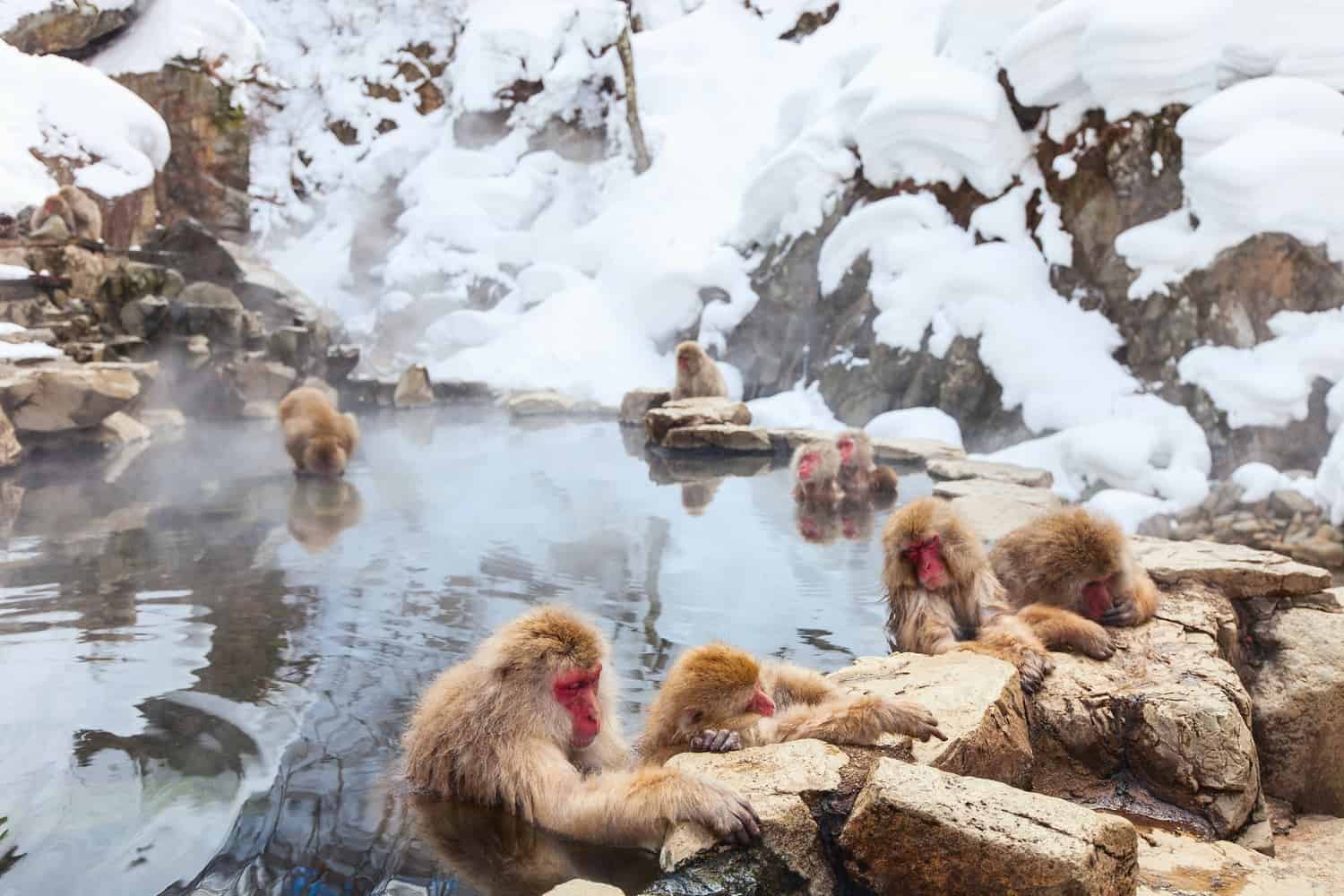
So how did it all go so wrong?
Our day began with a mishap.
I’d manipulated our Japan itinerary to include an illogical visit to the snow monkeys, and convinced myself it would be worth the long-winded adventure to get to them. I’d wanted to go since first learning about their home in 2011, and now that I had finally made it to Japan, was prepared to go all out in order to see them for myself.
Waking early, we jumped on our first train of the day, from our accommodation to the main station in Hakone. From there, we would need to switch to a train bound for Tokyo, change to a train heading to Nagano, and then leap on a train to Yudanaka. Our ryokan owner would then pick us from at the station, drive us to Jigokudani Monkey Park, and leave us to hike the 30 minutes up the mountain to the entrance.
It was going to be an exhausting day, and our route would see us battling to make numerous connections.
And then, of course, we missed our first one.
Which caused us to miss the next one.
And the next.
We were in a battle against the clock, desperate to make it to Yudanaka before the park closed, while struggling to contact the ryokan owner to let him know we’d be late.
When we finally pulled up at the station, two hours later than planned, we were driven straight to the monkeys. “Walk quickly,” the owner urged us. “The park closes in an hour.”
Most people estimate the walk up the mountain to take around half an hour, but we did it in just over 15. As we hurried, we pretended not to notice the lack of snow on the ground, and I instead told Dave about how I couldn’t be any more excited.
We arrived at the ticket office, red and sweaty, but convinced we were about to have one of the best experiences of our life.
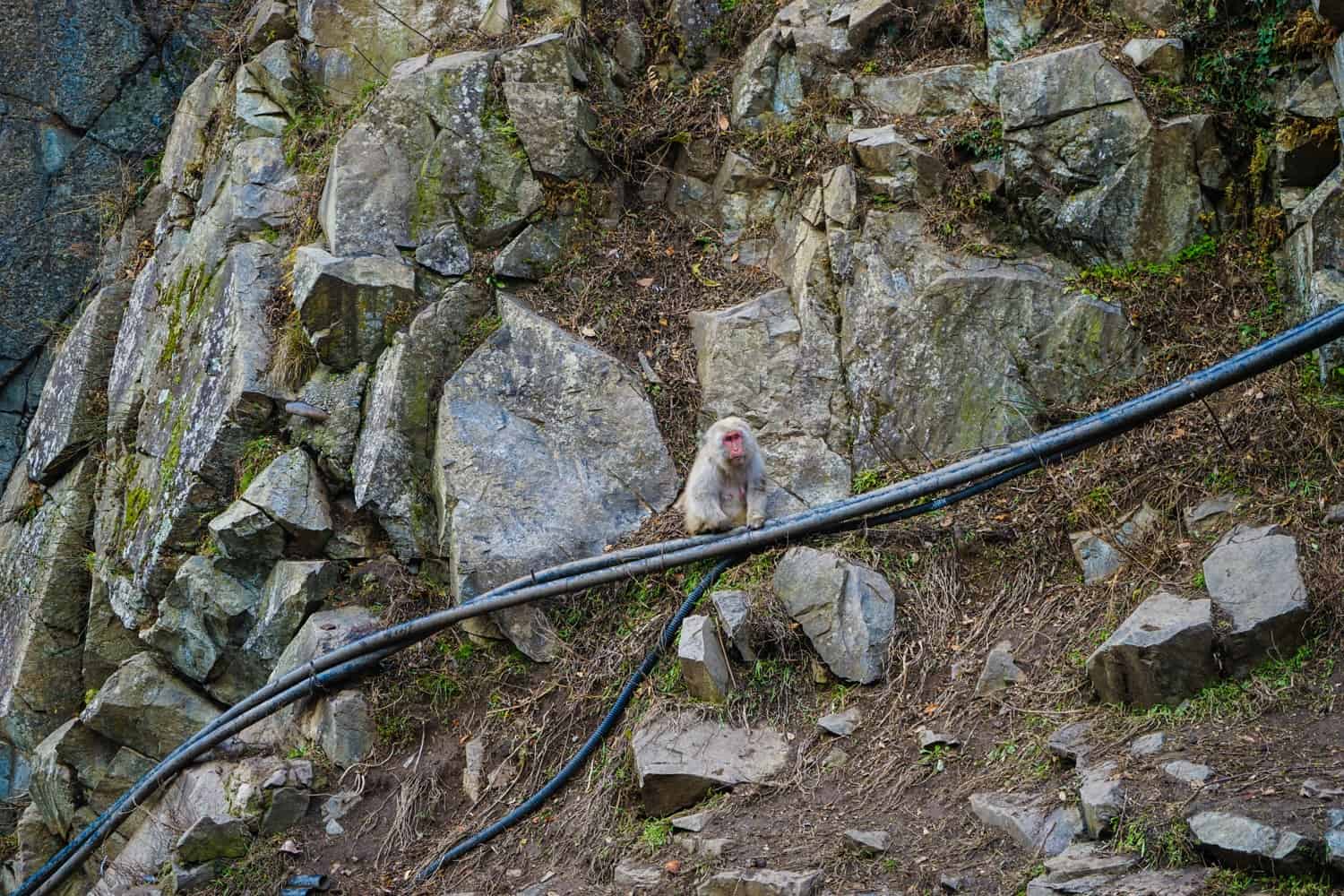
“Hurry,” the woman told us. “They’re leaving soon.”
We grabbed our tickets and ran down the path to the small onsen.
It was empty.
I frowned.
Suddenly, unexpectedly, I heard a sharp whistle radiating from the sky and gazed upwards. A huge horde of monkeys raced down a nearby slope towards us, bounding over rocks and skidding over gravel. I took a step back. Several minutes later, a man in Snow Monkey Park gear clambered after them.
I’d read online that the snow monkeys descend the mountain early each morning to relax in the onsen, and usually stick around until the afternoon. Clearly now was the time when they wanted to return back to their home, but there were paying tourists in the park, so the staff members weren’t letting them leave.
I felt uncomfortable as I watched them try to leave over and over again.
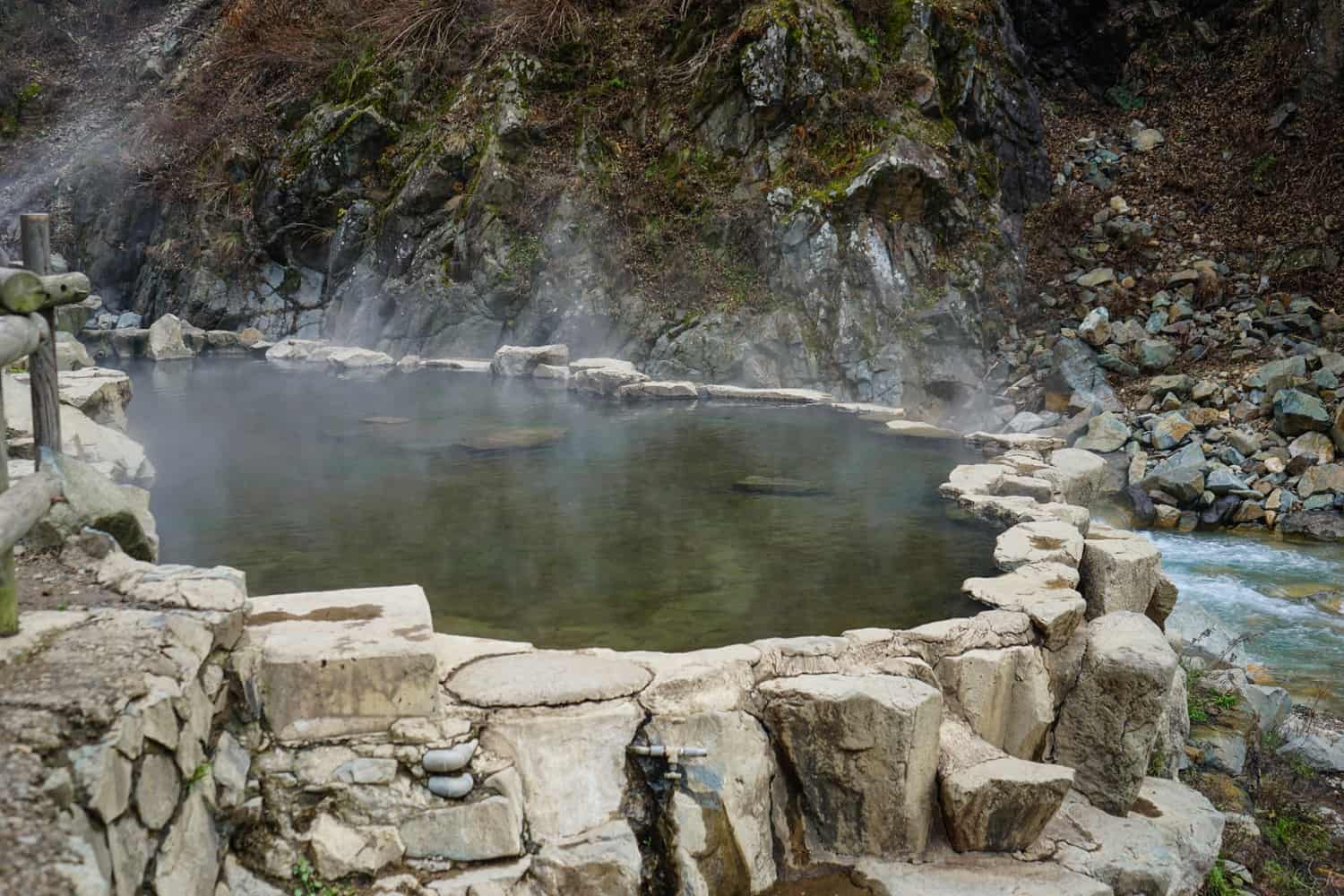
The hot springs were empty.
It turns out that when there’s no snow on the ground, the experience is more than disappointing.
Those famous photos you’ve seen of the snow monkeys that depict a gorgeous snowscape in the wilds of Japan? Well, when we were there, it looked more like a pile of rocks surrounding an small pool of water.
A pool of water that the monkeys were clearly avoiding going anywhere near.
I struggled to hide my disappointment as I watched the now-agitated monkeys fight and screech at each other. The staff member who had chased the macaques down the mountain was now standing with a bucket of food at his feet, throwing handfuls on the ground to keep the monkeys from leaving.
Whenever a monkey tried to leave? He ran after it and a few minutes later was encouraging back towards the hot springs.
When a different monkey showed signs of wanting to leave? He threw food at it to keep it around.
This site is pitched as a natural phenomenon, where monkeys happily bathe in hot springs and live their lives in calming harmony. The opposite, it turned out, was true. The monkeys at Jigokudani are essentially living in captivity, forced to spend their days around gawping humans rather than living in the onsen by choice.
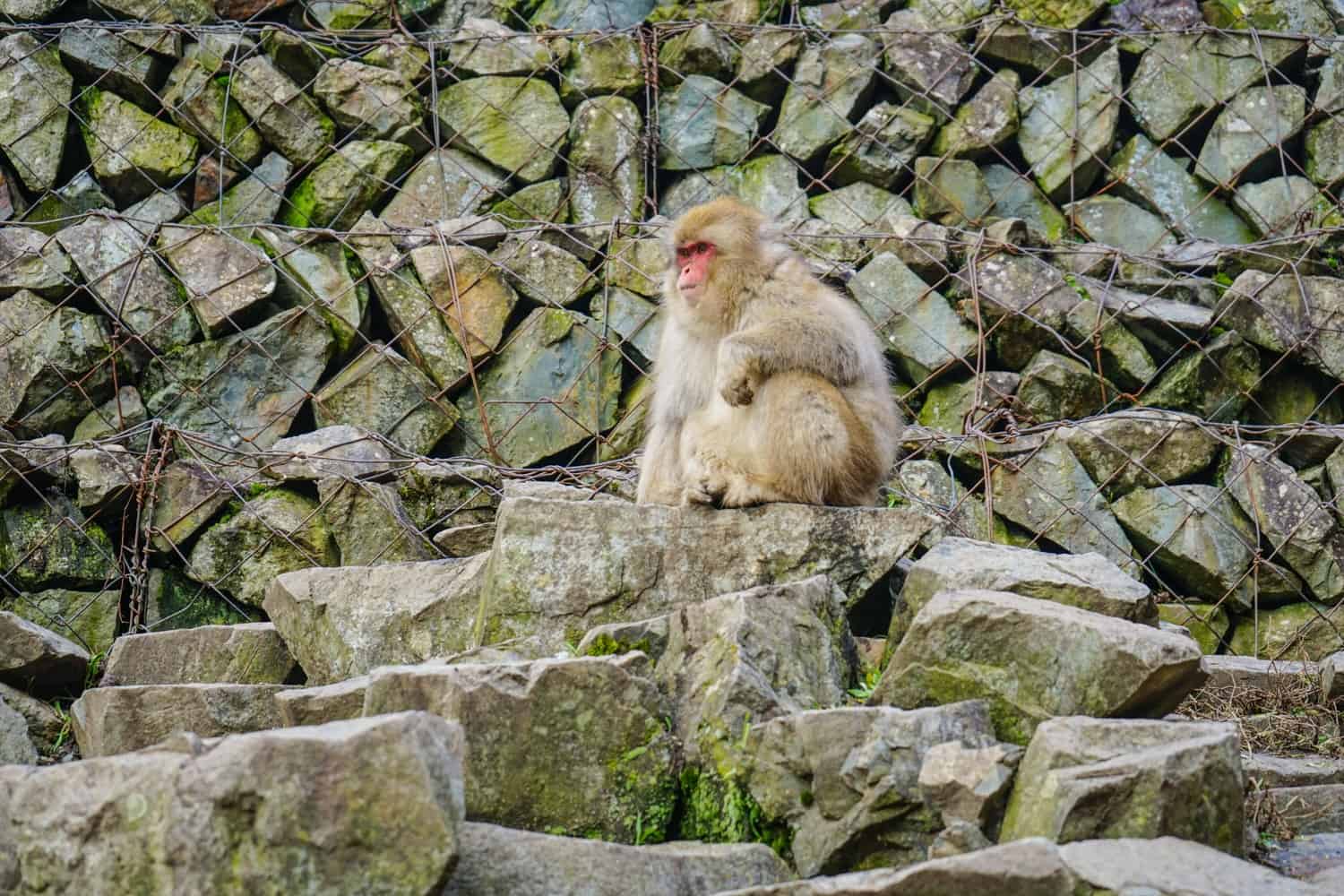
Dave and I turned to each other and winced.
I couldn’t believe my travel dream had ended up so tragic.
I couldn’t believe that something that’s touted as an organic experience with wild animals had been anything but. The monkeys seemed unhappy, agitated, and stressed. I hated that the macaques had been forced to spend time around paying customers, and I felt guilty for being the reason for their distress.
The other couple who was standing with us watching the scene looked just as uncomfortable.
Ten minutes after arriving, we turned and left.
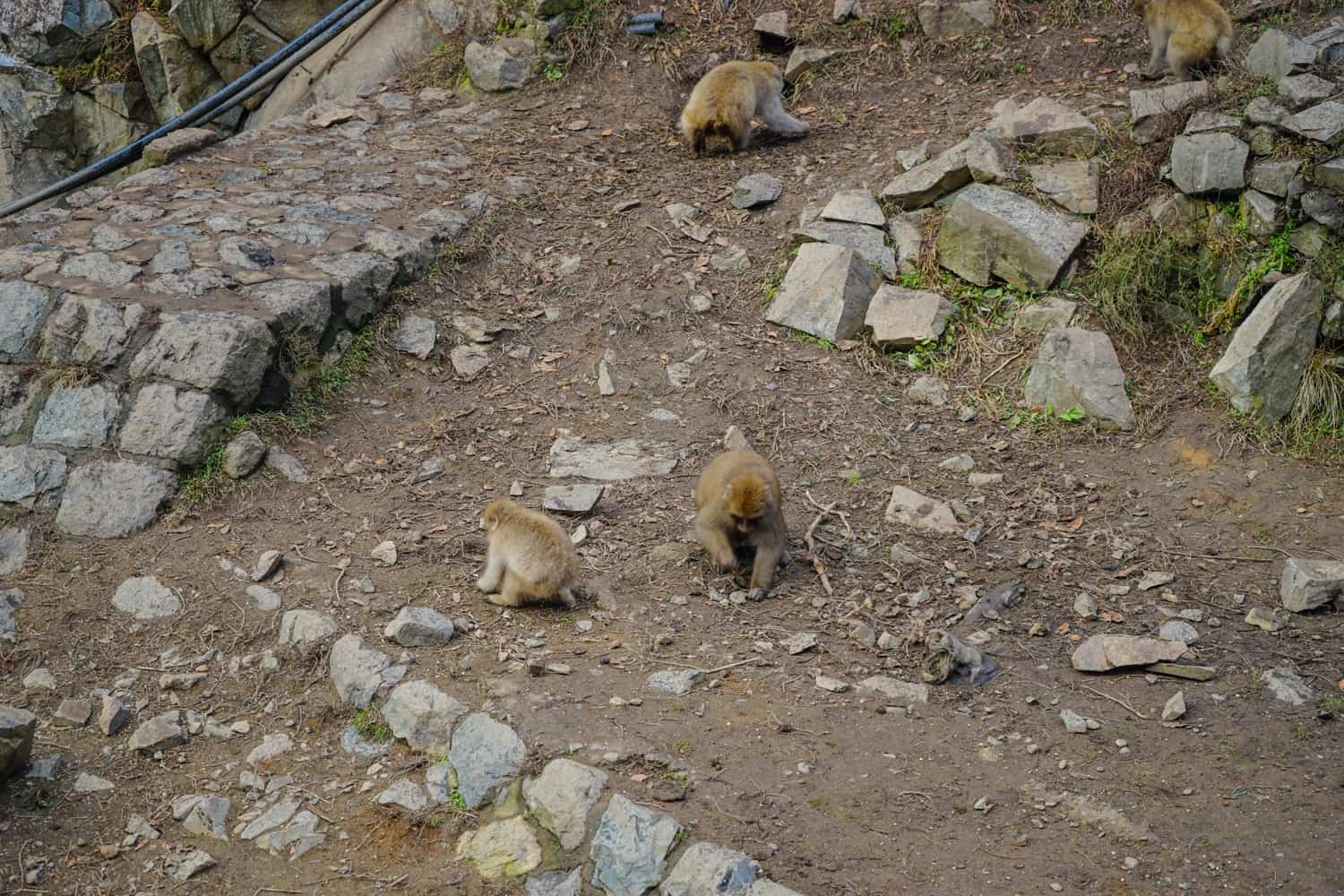
Upon reaching our ryokan, we stripped off and headed straight to the private onsen to mull it over. As we talked, the ground outside was slowly being blanketed in snow. And when we awoke the following morning, there was a glistening paradise awaiting us outside the window.
And… I wanted to return to the snow monkeys.
I know.
I’d paid to have a terrible experience, had witnessed dubious practices, and didn’t want to give the park more money.
But.
I’m also a travel writer and I always want to produce balanced pieces of work.
I also knew that if I wrote about how terrible my experience had been, people would think it was due to the lack of snow. I wanted to visit in the morning instead of the afternoon, and see the monkeys in the snow rather than the mud. I wanted to see if the monkeys were still forced to stay beside the onsen in the mornings; in the snow. My aim with my articles is to give an accurate look at what you’re likely to experience in different places in various situations.
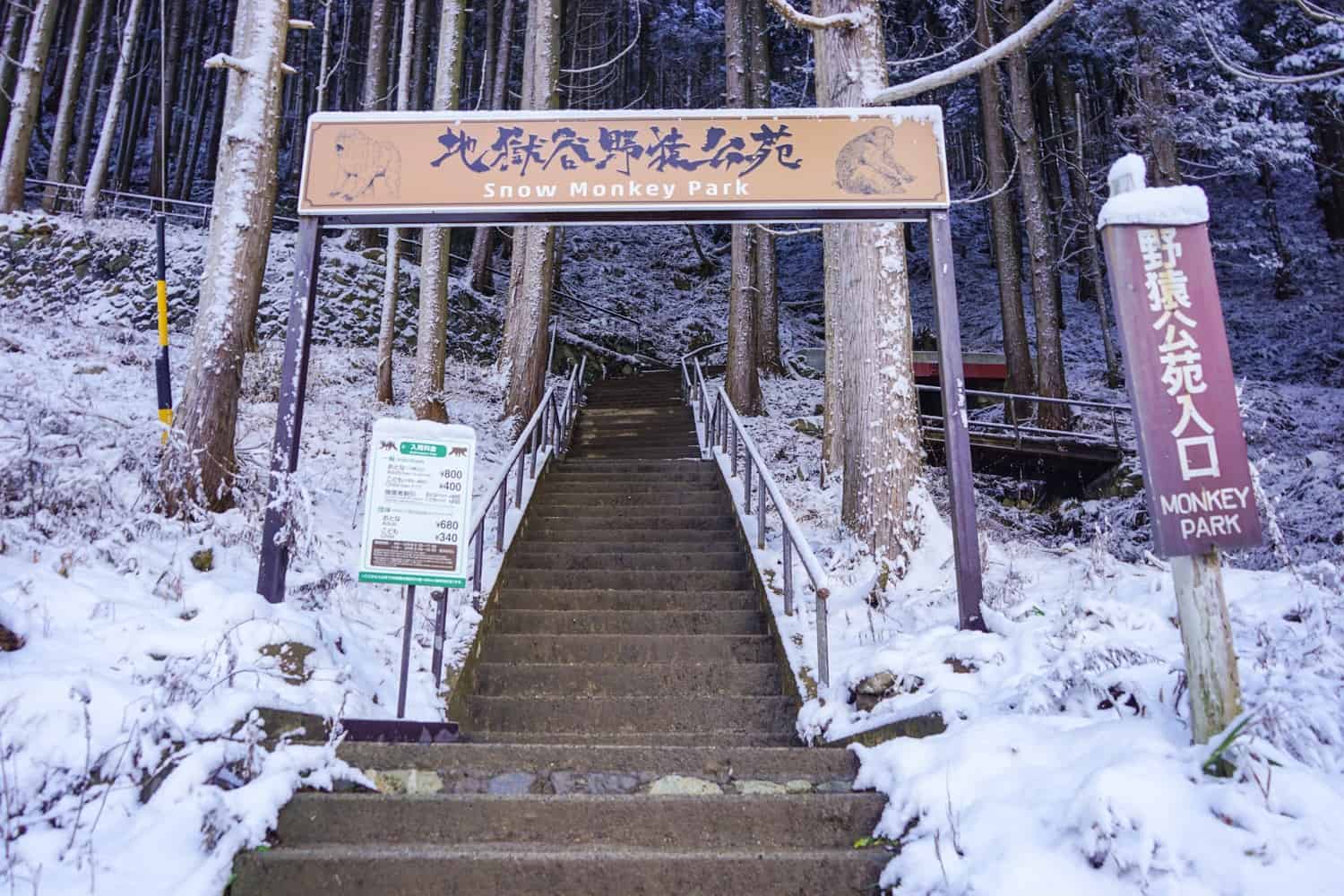
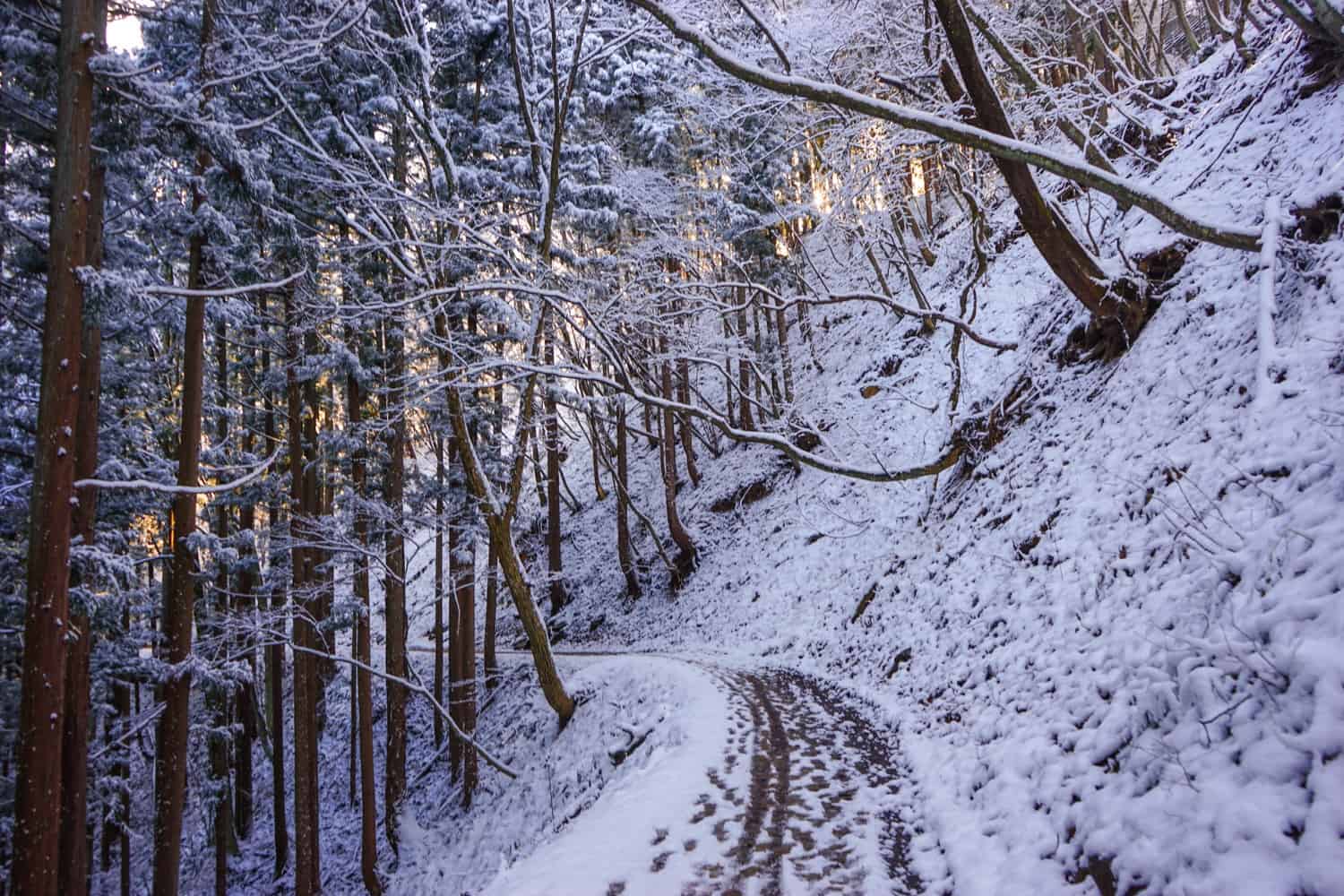
So, we went.
The ryokan owners were bemused when we told them we were returning for a second visit, but I was determined to see if the snow monkey experience could be saved.
We climbed for twenty minutes in silence, this time in awe of the snowy landscape. I was sliding all over the place in my gripless shoes, and thought about how I’d really regret my second visit if I died here.
We learned that we were the first visitors to the park of the day, paid again, slipped and slid over to the onsen, and it was like we were in a different place.
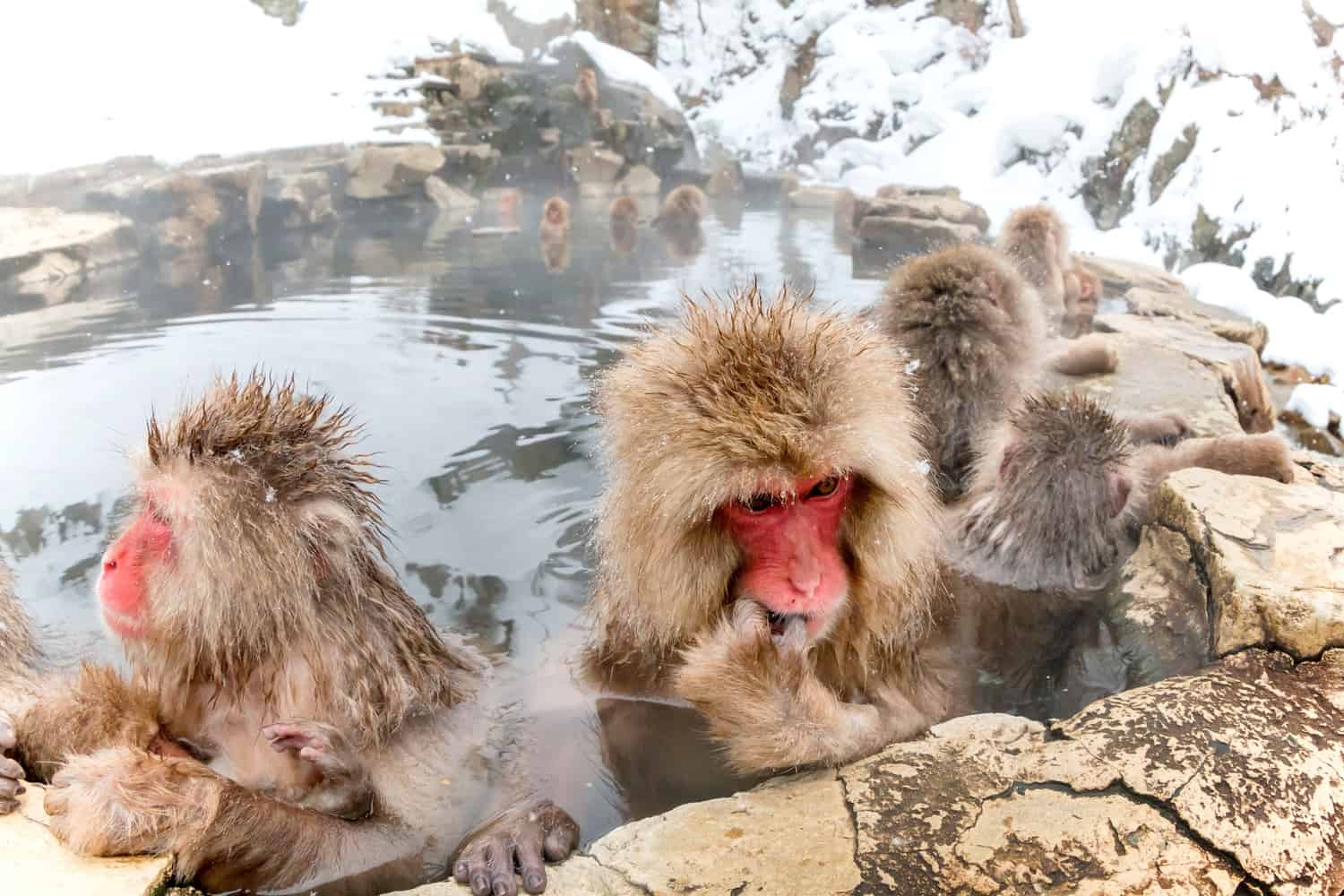
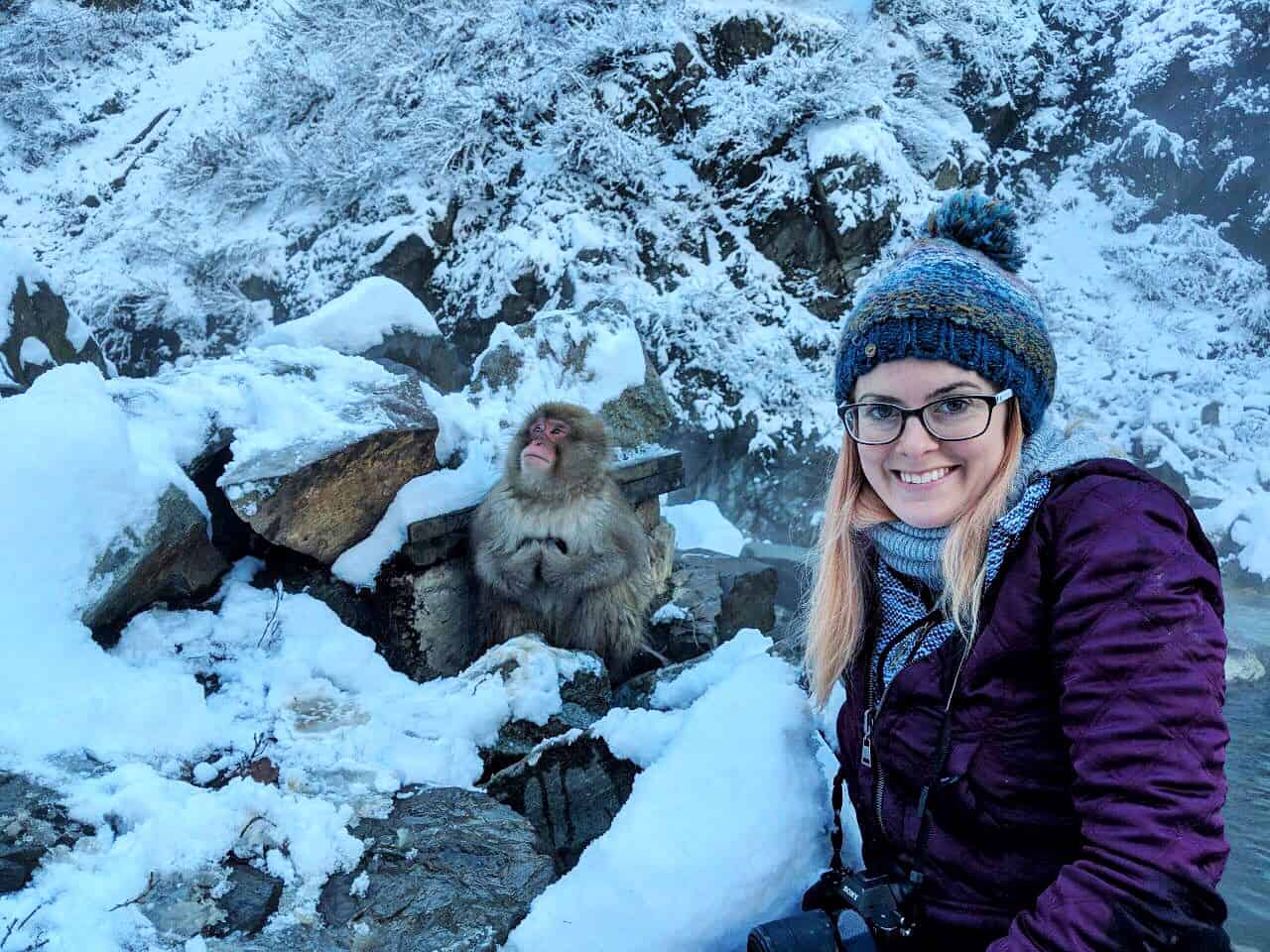
The monkeys were quiet and calm, and the surrounding area looked beautiful when blanketed in snow. We had a dozen macaques to observe without anybody else around.
None of the monkeys were being fed at this time of day, none of them were trying to leave the onsen, and none of them seemed in the least bit agitated.
It was as though the previous day had all been a dream.
We had an hour before we needed to head back to the train station, so we filled it by taking photos and videos, and simply watching the monkeys interact with each other. It was intimate, bizarre, and amazing all rolled into one.
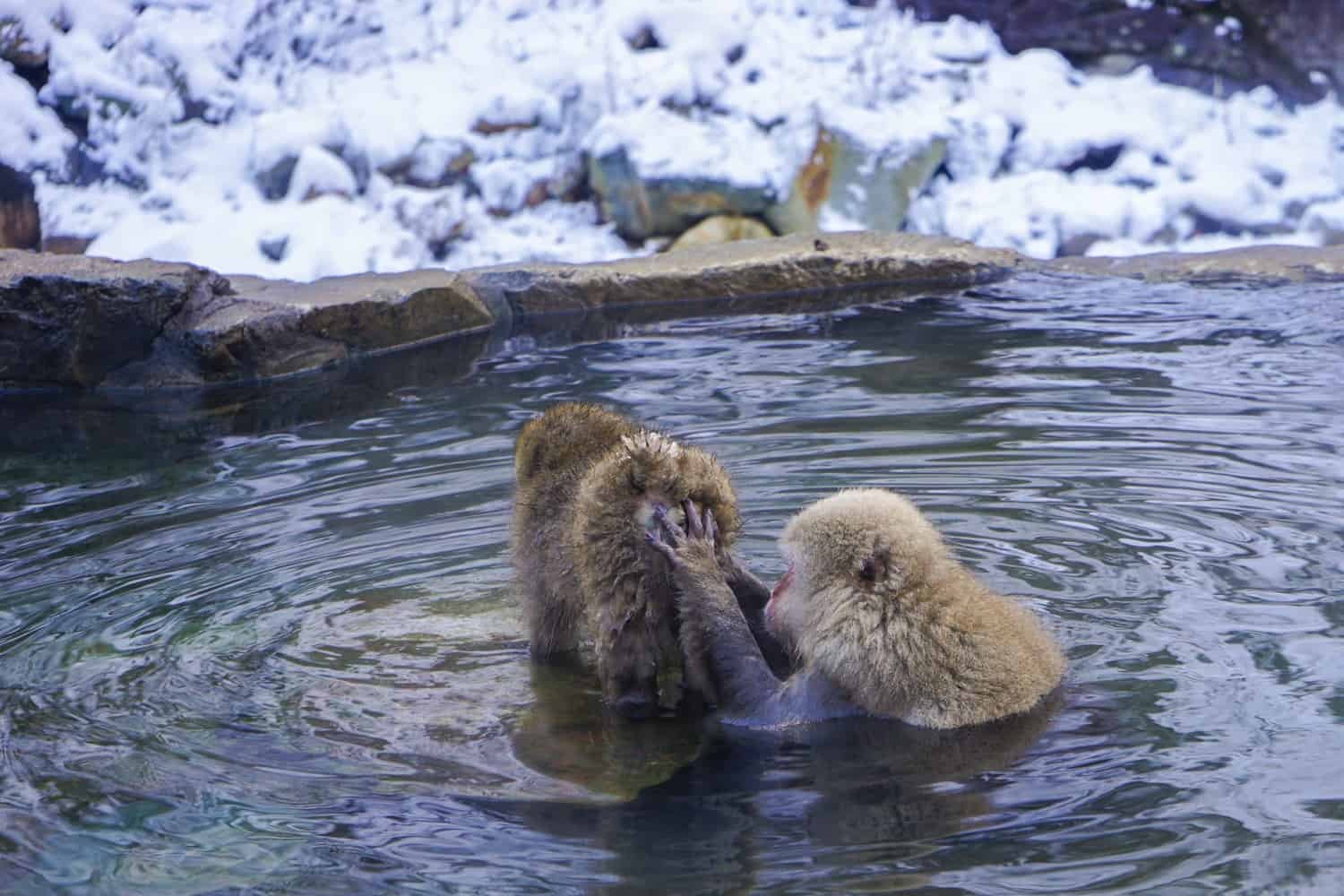
So now I was conflicted.
Despite having seen the monkeys in a seemingly happy state of mind, I also knew that come 3 p.m., the snow would have melted and the monkeys would be trying to head back up the mountain. If people were still paying to enter the park at that time, I had seen evidence that the monkeys would likely be fed in order to get them to stay.
Had I come to see the snow monkeys on that snowy morning and skipped the visit the day before, I would have labelled this one of the best things I’ve ever done. It would have felt like such an incredible, organic experience, not dissimilar to hiking to wild mountain gorillas in the D.R.C. But I can’t come to that conclusion after my experiences from the previous day.
I understand why the staff members attempt to keep the monkeys around the guests because, hey, if you had just spent 30 minutes hiking up a mountain in the cold, paid the entrance fee, and then found nothing waiting for you at the end, you’d label it a terrible experience. Ask for a refund. Likely give it a one-star review on TripAdvisor. Tell people not to bother going.
That doesn’t make the staff’s behaviour right, though.
The entire reason the park was created was to protect the monkeys from humans, and they’re now in a situation where the monkeys are being kept around humans. It’s disappointing, especially as the park was set up as a conservation effort at first. But tourism and tourism dollars have the power to ruin experiences like those.
And while we were lucky to be the first visitors to the park, that day, here’s what it looks like once the crowds have arrived:
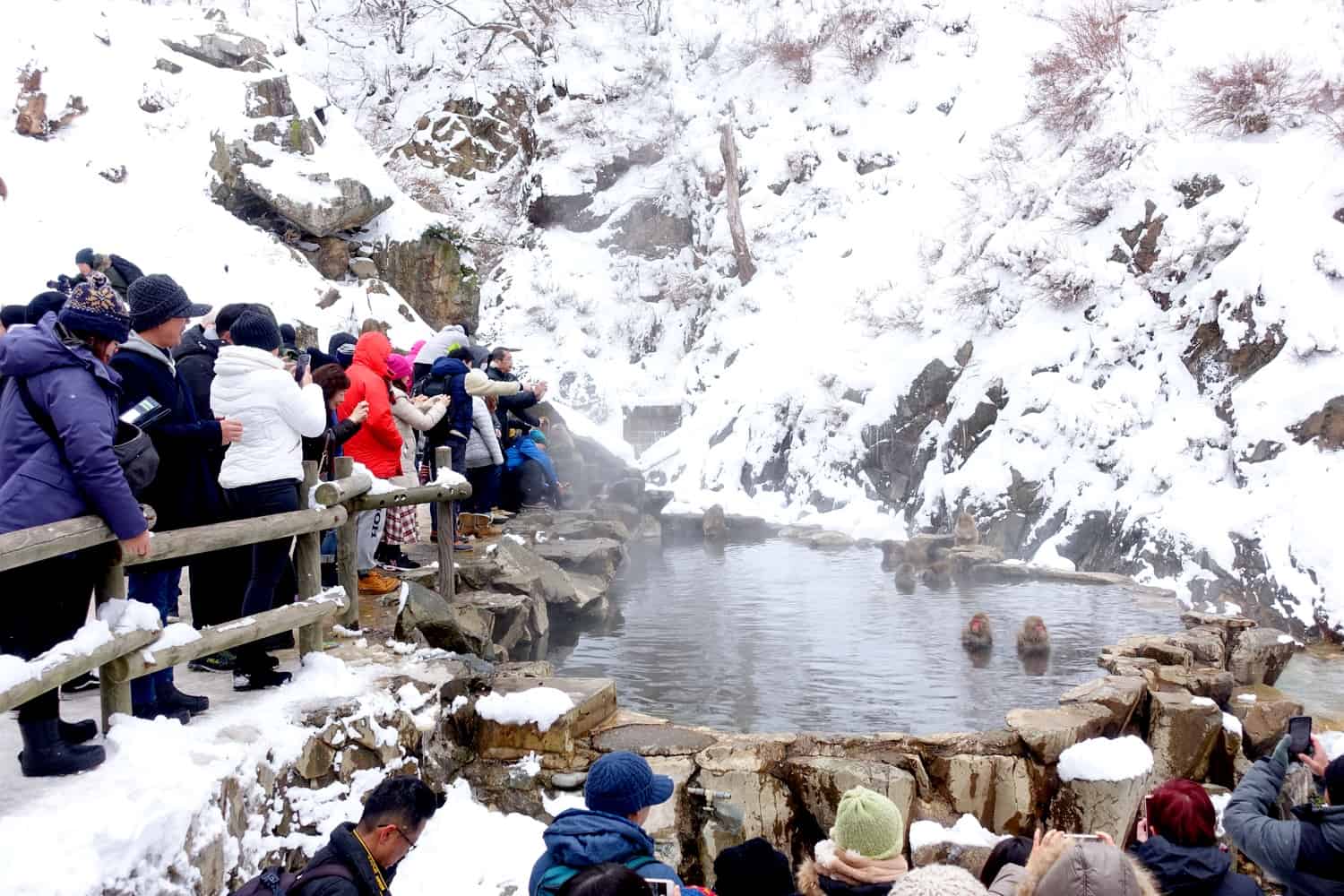
It looks like a zoo, and I can’t imagine the monkeys love being surrounded by thousands of people and cameras all day every day. What are the odds that genuinely wild animals would choose to put themselves in the situation depicted in the photo above? I just can’t see it.
Even more concerning, though, is the TripAdvisor review that recalls seeing a staff member using a slingshot and rocks to herd the monkeys towards the visitors.
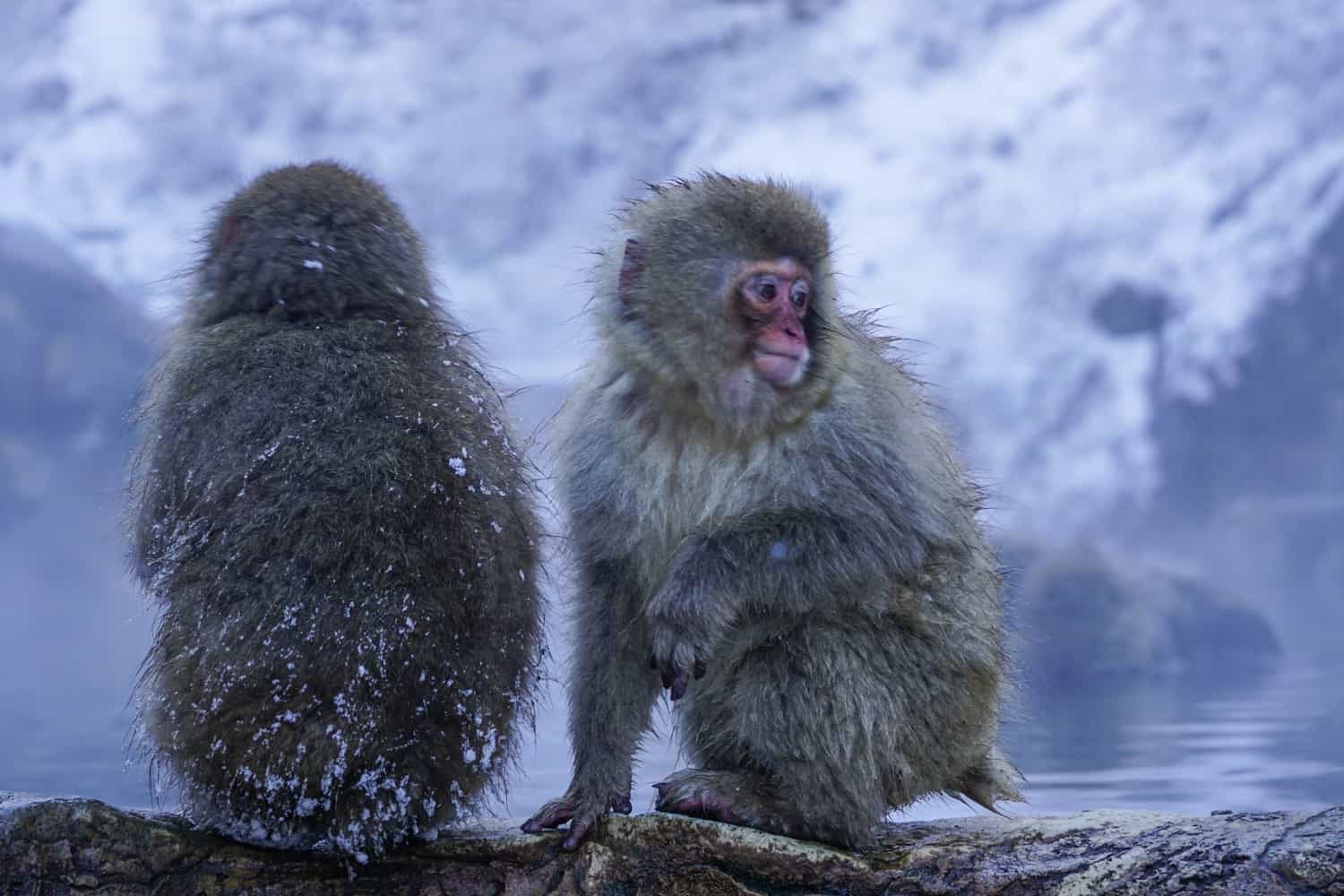
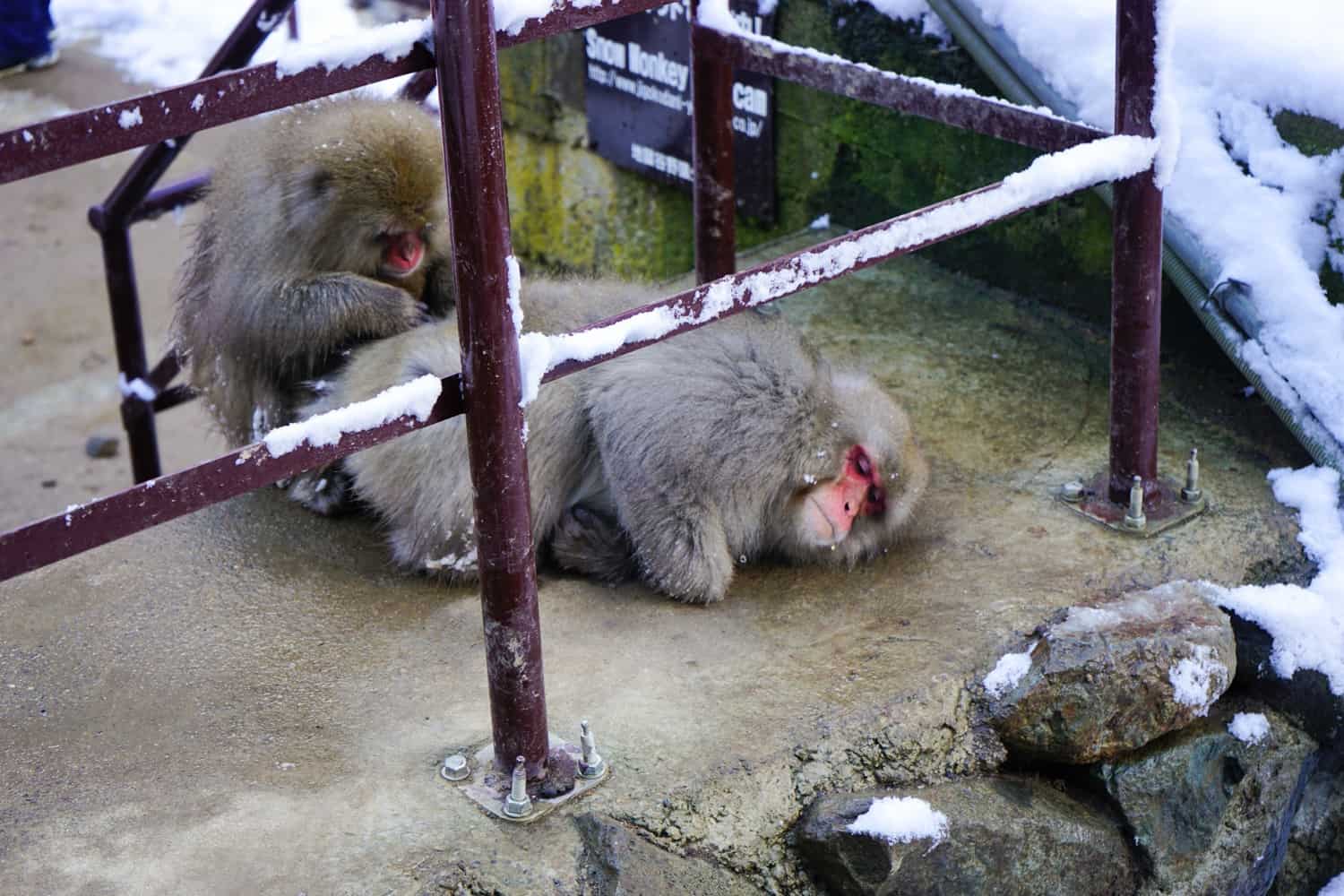
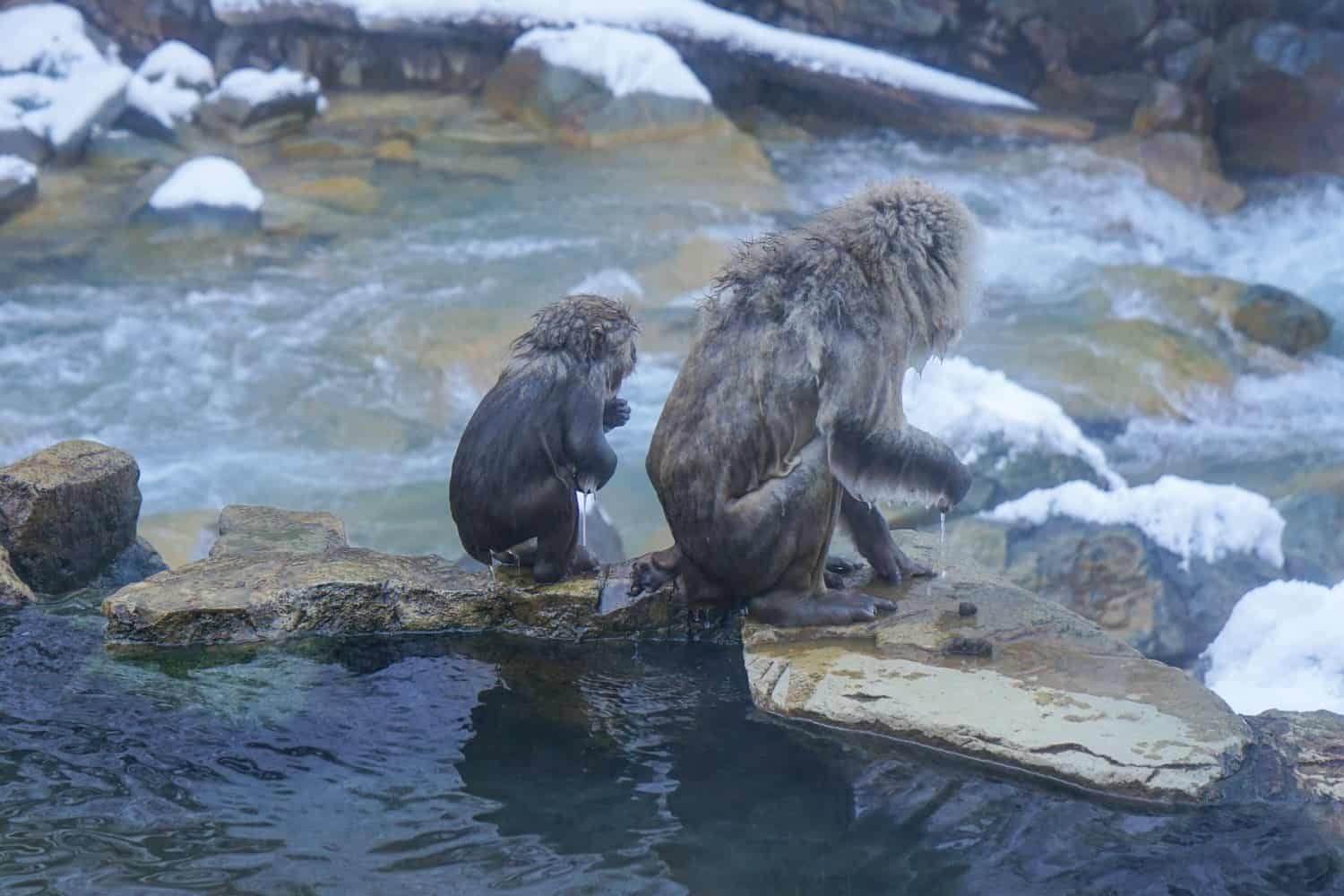
As I wrote in my hedgehog cafe post (because apparently all of my posts about Japan are focused on animal ethics), in the grand scheme of things, this wasn’t a horrific experience.
It wasn’t an organic experience.
It wasn’t a particularly ethical one.
But on the scale of animal and human cruelty, feeding monkeys and keeping them in one spot for several hours a day is nowhere near the most outrageous thing happening on the planet today. We all do things that are arguably worse — myself included — whether it’s eating meat, purchasing fast fashion, buying smartphones, using Amazon, or flying around the planet.
So, should you go or not?
That’s up to you and what you deem to be ethical. We all have different views when it comes to ethics, and we all draw our lines in different places.
I, personally, would not recommend visiting.
The monkeys are touted as being wild, and supposedly there are no fences so they can leave whenever they want, but when they’re being fed by staff members, why would they ever go off to find their own food sources? I think it’s important to know what you’re paying for, then, and to keep in mind that the monkeys may not necessarily want to be where they are. It’s down to you whether you want to support it or not.
So here’s my mini-guide for what to do if you do want to go.
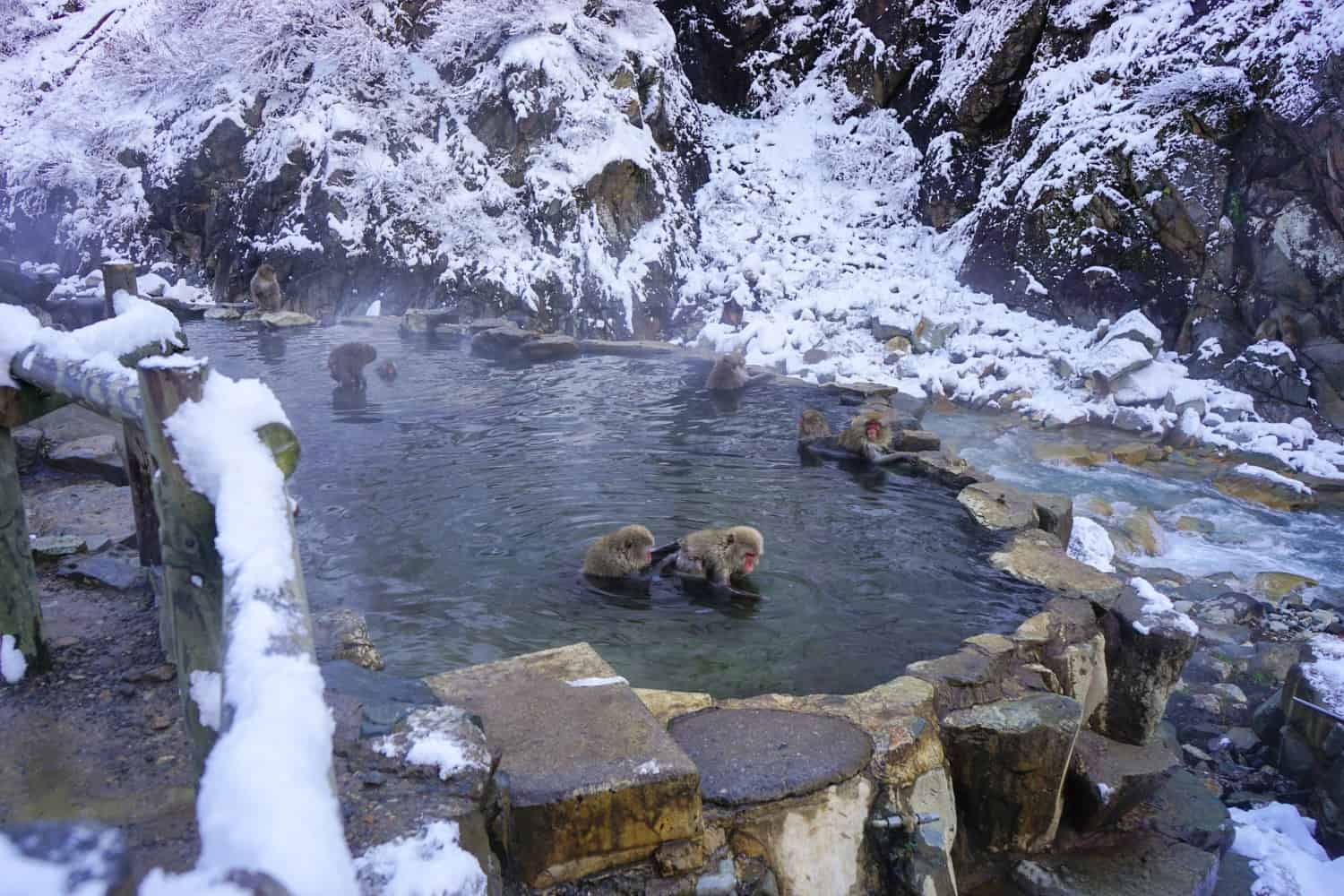
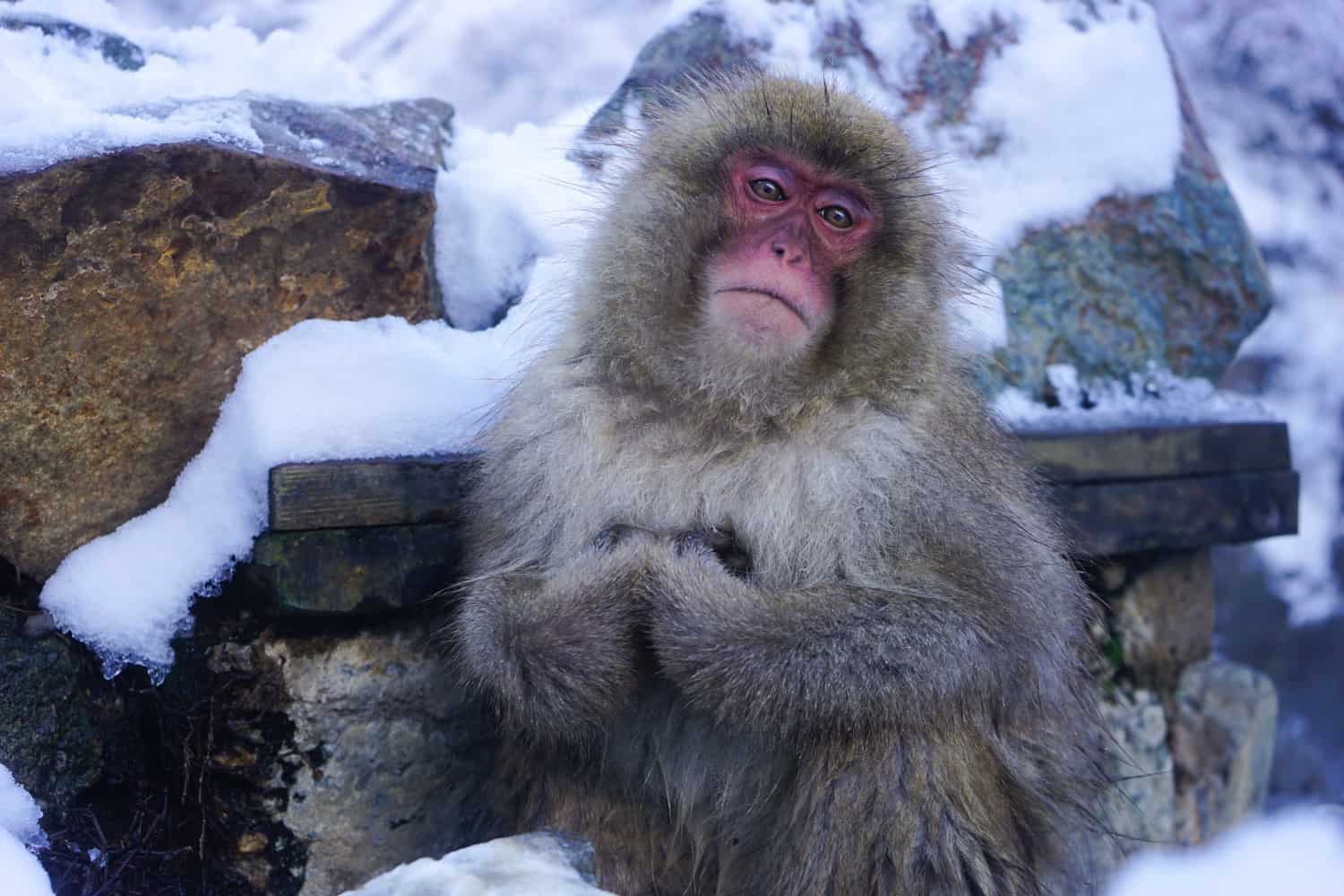
What to Know Before You Go
It costs $11/1,550¥ to see the snow monkeys.
Go in winter. This is the only time of year when you’ll be able to see the monkeys with snow, and if there’s none on the ground, don’t bother. Seriously. Not only will the monkeys not be in the onsen because it’ll be too hot, but they’ll also just be running around what looks like a construction site. Save your time and money and see one of the hundreds of amazing sights Japan has to offer instead.
You can see regular macaques all over the world — I’ve seen wild ones in about 20-odd countries by now — so I’d recommend taking the opportunity to see something unique instead.
(I visited in December, so stood a pretty good chance at seeing snow, but still had one day without any).
Check the webcam. There’s a webcam at the park that gives you a live view of what’s happening at the onsen. If you take a look and you don’t see any monkeys, it probably won’t be worth making the trek.
Go early. Jigokudani Monkey Park opens at 9 a.m., and you’ll then have a 20-30 minute hike in the snow to the hot springs. We arrived right when it opened and had the monkeys all to ourselves for a good 20 minutes. After we had spent an hour by the pool, the crowds were starting to arrive. I’d imagine that by midday, you’d struggle to even make your way to the front to take a photo, based on zoo-esque photo of people crowding around the monkeys that I shared above.
Another reason to go early is because the monkeys will want to leave the mountain later in the afternoon. By not visiting near closing time, you won’t be seeing the staff members doing everything they can to keep them around the paying visitors, so the monkeys will be happier. That doesn’t mean that these activities won’t go on, of course, but it’s certainly less distressing to not have to witness it.
What this means is that you shouldn’t visit as part of a day trip from Tokyo, unless you leave ridiculously early, because otherwise you might get there too late.
Stay in Yudanaka: We stayed in a cosy ryokan, which is something you have to experience at least once in Japan. With prices often reaching as high as $300 a night for the experience, I was thrilled when I stumbled across a more budget option in Yudanaka (just $90 a night!). It was run by an adorable Japanese couple, and their house came with a private onsen, return transport to the snow monkeys, and one of the most extravagant meals of my life. A kaiseki is a multi-course meal that will see you eating what feels like a week’s worth of food in a single night, sampling fresh, local Japanese cuisine. It was delicious, and I adored having no idea what anything was. I highly recommend the experience, although being presented with a seven course meal for breakfast had me on the verge of tears the morning after.
Consider hiring extra gear: People get injured on the slopes up the mountain so consider renting snowshoes and an umbrella (to protect you from snow smacking you on the head from the trees above) to keep you safe. I didn’t bother with this, but almost fell over multiple times, and probably shouldn’t have risked it.
Expect to struggle with photo-taking: What do you get when you combine hot water with snow? Yep, a whole load of steam, and your camera is going to want to focus on it. I struggled to get great photos because the steam made everything look washed out, my camera struggled to focus on the monkeys, and they moved so quickly it was hard to get a sharp image. Arrive with low expectations in the hope that they’ll be exceeded.
Oh, and make sure your camera battery is fully charged before you arrive — the cold weather will drain your battery shockingly fast. Mine was dead within 30 minutes when it usually would have lasted for at least five or six hours.
You can take a tour if you prefer: For $100, you can opt to jump on a full-day tour that picks you up from Nagano train station. You’ll be taken to the snow monkeys, as well as the nearby Zenkoji temple, and sample sake from a local craft brewery. This tour is popular, however, and sometimes sells out weeks in advance. If you would prefer to have a guide for your experience, I recommend booking as soon as you can. You can check availability using the widget below:
Have you ever ended up disappointed by something you’d always dreamed of seeing?
Please note: I’ve decided to close comments on this article after things ended up getting a little heated and the continual attacks I was receiving began to negatively impact my mental health. But I recommend browsing through them for a balanced look at the snow monkeys. Some people had a similar experience to me; others had a fantastic time and couldn’t recommend it enough. Like most things in life, anecdotes don’t equal facts, so take everything with a grain of salt.
Related Articles on Japan
🇯🇵 What’s it Like to Travel in Japan?
🏯 How to Spend Two Weeks in Japan: An Itinerary for First-Time Visitors
💴 The Cost of Travel in Japan: A 2023 Budget Breakdown
🍣 15 Weird and Wonderful Things to Eat in Japan
🎌 23 Incredible Things to Do in Osaka, Japan
😎 Hipster Harajuku: The Coolest Neighbourhood in Tokyo
🦔 Should You Go to a Hedgehog Cafe? My Experience in Japan
Photo credits: BlueOrange Studio/Shutterstock; Norikko/Shutterstock; Lydiarei/Shutterstock.





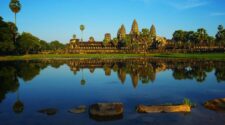
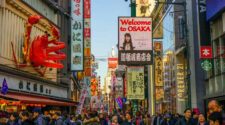
Totally a bucket list item, although now, after reading part one, I too am conflicted. In the end though, it’s good information to know for if and when I decide to visit.
Question for you… Do you have an actual bucket list of things that you’d like to do, or just a metaphorical one whereby you cross things off when you visit them, but nothing’s actually written down? It would be interesting to see yours if you have one written down.
No, not really. It sounds super douchey but as soon as I think, hmmm, I’d really like to do something, I usually have the freedom to just go and do it, so I typically cross things off as soon as I come up with them. If I did have one, it would likely just be to go to every country in Africa because I can’t get enough of travelling in the continent!
I truly appreciate this post, so saddened that the experience is not what is portrayed and that farmers and land owners in Japan are as awful as those here in the U.S. I would rather hike for days into the wilderness to get a glimpse of one in the wild than see this circus show.
We just returned from New Zealand which was a let down, beautiful landscapes over filled with millions of tourists everywhere and kitschy helicopter trips and rafting excursions by people not putting two and two together as to that is why the glaciers are receding. A country that also lacked a lot of culture and by far the WORST FOOD IN THE WORLD (sorry I know your partner is from N.Z.) and sand flies. After readying hundreds of travel posts and blogs about New Zealand and not one mentioned sand flies.
So I appreciate the heads up and honesty, so hard to get the real scoop on many travel places now-a-days as everyone is comped. Also the devastation that yet another great bucket list dream is really just a farce…..
Thanks:-)
I read your comment out to Dave and he said, “No need to apologise — I pretty much agree with all of it.” Hahaha. There’s a reason why he’s been travelling for the past 20 years! For what it’s worth, I haven’t encountered any sand flies in New Zealand after spending 3+ months there, but yeah, the touristy stuff can be crazy-expensive, damaging to the environment, and crowded. There’s definitely some off-the-beaten track hikes and stuff that are rarely visited and beautiful, but I know I only discovered them because of my boyfriend’s family, so it’s not easily accessible to visitors. Sorry your trip to NZ ended up being such a disappointment!
Sad to read that your trip to NZ was a let down. Surprised you didn’t read about the sandflies as they are famous at some tourist spots down south. While NZ, like the US, is not be a place to travel to for food it is not that bad! Usually it is the weather that ruins peoples holidays. And also the lack of good transport options. And yes it is expensive but you dont have to jump off a bridge to enjoy it!
So the lesson from both this post and your trip is that travel is more than a postcard photo.
I am once again so happy that I stumbled across this post. Because for me as well seeing the snow monkeys has been a dream and since I am headed to Tokyo soon I was wondering if I should make a detour. Thinking I should rather wait for winter you have confirmed that the place needs snow and that it is not a real conservation effort anymore – how very disappointing. Not sure I will want to ever go now.
Yes, I’d definitely recommend waiting until winter if you do decide to go. I was surprised how ugly the place was when there wasn’t snow. You really just stand there and look at a dozen monkeys running over some dirt and rocks.
Isn’t Japan a fascinating place? You really can’t help but be impacted by the Japanese sense of ethics, communal responsibility and crazy serious adherence to rules. It’s the only place I’ve ever been where they have a sign for “no roughhousing” on the escalator. It’s also one of the only places I’ve been where I could walk anywhere in the middle of the night and feel 100% safe. Our taxi driver got lost in Tokyo and then refused payment for causing a very slight delay, so I totally get the situation at the monkey park. We saw them in May and I agree with everything you’ve said about the atmosphere. I would mention that our visit was pretty amazing because the monkeys had just had their babies. I’ve never seen a mother animal so unfazed by people, so that definitely is a clue to how “wild” they are, but oh my God those babies were so cute! Did you get to Nara to see the bowing deer?
Thanks for your honesty!
Thanks for sharing this post! I can’t believe I hadn’t read or seen anything about that side of the park before…although maybe other bloggers just had better timing and weren’t aware of how the monkeys are treated later in the day. Anyway, thanks for shedding some light on it!
I was definitely surprised by the lack of discussion around it. When I came to research this article, I saw a few TripAdvisor reviews talking about poor treatment of the monkeys, but 95% of what I came across was positive. Of course, if I’d only visited on that snowy morning, I would have thought it was an incredible place.
Another great, honest post, thank you! I’m glad you went back to get a second, completely different view of it, but I’d definitely be conflicted too. Like you say, there are far worse things going on, but does that make it right?
I really appreciate the amount of thought that you’ve put into this post and the hedgehog café post. It’s so important to consider the animal welfare aspects of these attractions and by explaining things so clearly I believe that you’ll help people make informed decisions. My partner and I are going to Sri Lanka soon and are planning on going to see elephants; we’ve only found one place that seems more focused on the welfare of the elephants as opposed to the tourist attraction side of it. Thank you for being a responsible traveler and advisor <3
Thank you for your honesty. I’m a huge advocate for animal welfare and attractions like these are bad for the animals. I gasped when I saw the photo of the monkeys in the pools surrounded by a hundred tourists with cameras! They may not be in cages, but it seems like they’re living in captivity regardless. Animals like these are supposed to be wild, and once they’re being fed, they become unnaturally accustomed to humans, start to rely on them for food, and can even start attacking people because they now think of them as a food source.
I woudnt agree more with you to be honest.
:-)
I had a really similar experience visiting a monkey sanctuary in a small mountain town an hour out of Tokyo. We didn’t go there specifically for the monkeys, but figured it would be a shame to miss it. The enclosure was alarmingly small for the large number of animals. The entire enclosure was concrete with some ropes for the monkeys to play on. Most alarmingly, there were a number of monkeys who looked emotionally disturbed, rocking back and forth. We left feeling horrified!
Oh man, it really does seem like there are very few (if any) ethical animal experiences in Japan.
It’s always so sad when tourism trumps an animal’s welfare. I work as a veterinary assistant and love traveling to see different species of animals, but I have to be so careful not to give my money to businesses that do not treat the animals with respect!
Gosh, I feel like one of my dreams has been a bit crushed by this post. Though I do appreciate stumbling across it. I’ve seen the gorillas in Rwanda and volunteered with wildlife around the world and would feel awful to see people being like that towards the monkeys.
I’m torn now as I was planning a trip with this highlight next winter… but always best to be informed to make the right decision, so thanks! Great posts about budget and planning too!
Hi ,
When is the best time (month) to visit Snow monkeys ? Is there any dormitory accommodation available near by ? or some budget hotels ?
Thanks
Murthy
We are arriving in japan, this was something I would of liked to have done. Can you pay a entry ticket or do you have to do a tour. What was the price of entry for adults?
As we are coming from Ks place in Hakuba, we are going to snow monkeys from their, would you suggest this or going to Mt Fuji or Nikko
That information is in the blog post. It’s 800 Yen per person to enter, and it’s only an entry ticket — no tours.
I’d suggest going to Mount Fuji over the snow monkeys, for the reasons outlined in this article. I haven’t been to Nikko, so can’t comment on what it’s like.
Hi! Wonderful post.. This really made me think twice about seeing the snow monkeys.. May I know your dates of travel?
I was there during the first week of December.
This is quite disheartening to read this, especially since I enjoy studying Japan’s culture for years, but spreading the truth is always a must. Thanks for sharing this.
One of the most surprising realisations I had during my trip to Japan is that there’s a hell of a lot of unethical animal attractions across the country. Fortunately, it has so much more to offer visitors :-)
Thank you for the post! In tow I have a 2 year old whom I would have trekked all the way up to see the snow monkeys (we are on our way today to Kanazawa)
Instead I’ll change my plans to go onwards to some place else!
Thank you for the honesty!
No problem! Hope you have a wonderful time doing whatever you decide to do instead :-)
Yeah it’s a tough thing between what’s ethical and what may not be ethical to another.
It’s always nice to see that the animals are at least happy and enjoying themselves.
I appreciate this. Having been to see the Snow Monkeys twice now (ten years apart) and both times going at the end of winter but in the morning, I never saw the late-afternoon abuse you did. However, I did see the park with no snow, and while it does look nothing like a winter wonderland, I enjoyed the walk on the mountainside with my family.
At first, this article made me upset, because I enjoyed myself – but after reading the whole, I think you arrived at an honest, reasonable conclusion that I have to take to heart. While I think it’s worth the visit, and reviews and exposure like this are also important – Finding a way to protect the monkeys from being driven out, but also offering a more real and less “catered” experience would be ideal.
Side note – ten years ago, there were monkeys of the same kind on Miyajima island, and they were much more wild. I was sad to find, when we returned last year, that they had been removed because of the nuisance they were causing. Nothing gold can stay, I suppose.
Hi Lauren,
Thanks a lot for your post! We are about to go to Japan this spring and my girlfriend would love to see wild monkeys. I too love to see wild animals but I hate animal circus and arranged pseudo-wilderness. So we are definitely not going to this place after reading this. Do you actually know a hike in a region in Japan where you get a chance to see wild (I mean really wild) monkeys? Thanks
I make a point to not support this type of tourism.
Hi Lauren.
Thanks for the post. I was dragged there in 2012 by a friend who also had it on her bucket list – thanks to them featuring BBC Earth. It looks like it wasn’t as popular back then or maybe offseason as there wasn’t a lot of snow on walk but luckily still plenty at pools. Our main trouble was getting there as got a bit lost as got dropped off at wrong place! Had lots of time with the monkeys who kept coming up to us. Like you stayed at Ryokan which was great along with all the onsen in the town you get a key to (I can’t recall the name). Certainly wouldnt do as day trip from Tokyo! I am going back to Japan at end of year but will be exploring new places as well as catching up with some people I met. And of course staying at lots of Ryokan and enjoying the food!
Thank you for writing about this! I was considering a visit here but like you, I am all about animal rights and ethical practices. So this would be a no for me. I hope they find a way to keep it “natural” and “organic” for the monkeys.
Thank you so much for this post! Im going next month to snow monkey park with mom and sister but now I’m feeling mortified after reading this post! If I had known that the monkeys were treated that way, no way we would of booked it! Like yourself, we are going out of our way to make sure that we would see the monkeys! Now I wish we didn’t ! Too late to take out
Of the itenerary!
Thank you so much for this post about the snow monkeys. It describes everything I was wondering about them after seeing pictures online. And I really appreciate your honest report and reflecting on the experience of the visit. First rate report both from information standpoint as well as your personal experience. Thanks so much.
Read this just now, after joining a discussion on the photography-oriented Facebook page ‘No More Game Farms.’ That discussion was about the ethics — or lack of same — surrounding so-called “Wildlife Photography Game Farms,” like the one in Kalispell, Montana (quite famous, actually). I remember, a couple of years ago, an award-winning, up-and-coming nature photographer I happen to know quite well, told me, after I told her one of my dreams was to photograph the Japanese snow monkeys, that they’re now being baited (food put out for them) year-round, and not just in winter, changing their behaviour. She thought this to be really unethical, and gently — but firmly — tried to talk me out of it. The point was moot — a trip to Japan is not in my budget anyway, or on my list of photo priorities. I was prompted to do some research, however, which is how I found your post. I worked 35+ years in journalism, for a proper newspaper, with rigorous reporting standards, and so I know good, honest digging when I see it. At first, I thought this was going to be one of those silly, light-hearted blog posts — and long! — that are all the rage these days on social media. In fact, after reading this from beginning to end, I can tell it’s honest, heartfelt and, I suspect, dead-on accurate. You clearly went to a lot of effort to relate your experience, in no small amount of detail. Good for you. Thanks for posting, thanks for sharing. One of our editor-in-chiefs back in the day had a saying: Be tough, but fair. This was both IMO.
Thank you so much, Alex! That means a lot.
Thanks for your post Lauren, I found it invaluable. It has definitely made me reconsider seeing the snow monkeys especially as we are travelling there in the first week of December. If we go, we will definitely go in the morning as we are travelling up the old Post Rail route from Nagano so now I feel less like I’ll be rushing through this to get there.
I must say regarding the earlier and comments (I am also from NZ) they were a bit harsh. I have travelled to many places and I still find NZ so incredibly beautiful. It’s always about your personal experience and I always try to avoid the touristy spots (apart from the snow monkeys!) there are so many great places to see in NZ but you must do your research. The food and coffee is generally fantastic ( better than the US which I found to be bland) but I will always go to places that have been recommended to me at at not popular ones. I think this makes the difference.
Thanks for this honest report. It gives a fair reflection.
I have mixed feelings about the park myself, partly because I help run a car rental company in the ski resort Hakuba called Freedom Car Rental (https://freedomhakuba.com). The snow monkeys are a popular destination and car rental is one way to get there before the crowds arrive, in the manner Lauren describes above.
My feelings are further conflicted because I am a cyclist and frequently see troupes of genuinely wild macaques when out riding in Nagano. If you know where to go, it is easy to find them. The BBC filmed some of these monkeys raiding orchards in Honshu episode of its “Japan: Earth’s Enchanted Islands”/”Wild Japan” miniseries. For anyone interested, that footage was shot along Route 306 at the base of the Japan Alps in Omachi.
That all said, it is undeniable that monkeys are cute, monkeys you can see close up are special, and monkeys relaxing in a hot spring are an endearing and unforgettable sight. They are world famous for a reason. The Snow Monkey Park at Jigokudani could be done better, the facilities there are cheaply built and unsympathetic to the natural setting, but that doesn’t mean you can’t enjoy a trip there. Japan has many zoos, bear parks, and aquariums where animals are genuinely mistreated. That is not the case here.
Your article was so insightful and just convinced me not to visit. I was excited about the prospect of chilling with monkeys in the wilderness, but after reading about the unethical practices, I do not want to contribute or take any part of it!!! Thank you.
This account reads like the privileged individual that you are. “I had a horrible experience, but I went back.” “Should you go? That depends on your definition of ethical.” Are you kidding me there’s only one definition of ethical. Animals should never be exploited stop supporting this shit. If an animal is caged or forced into doing something don’t support the establishment. You said so yourself they’re driven by yelp reviews. Even you went back for the better photos for your blog. Jesus Christ. This isn’t hard if something feels wrong it IS. Visit a sanctuary or go on a safari – stop falling into tourist traps for your stupid blog.
I wasn’t going back for better photos for my blog, but so that I could write a more balanced article. As I stated in my piece: “I’d paid to have a terrible experience, had witnessed dubious practices, and didn’t want to give the park more money. But. I also knew that if I wrote about how terrible my experience had been, people would think it was due to the lack of snow. I wanted to visit in the morning instead of the afternoon, and see the monkeys in the snow rather than the mud. I wanted to be able to give a more balanced opinion.”
No need to be such a dick. Ethics are a grey area, because it’s impossible to live a truly ethical life. I’m sure you do hundreds of worse things in life than paying to see a dozen monkeys be forced down a mountain. Like, you know, owning a smartphone that was mined by child slaves.
I would feel like a hypocrite to insist that nobody should support this park when I take dozens of flights each year, when I buy from companies like Amazon, when I buy clothes from fast fashion brands, when I stay in Airbnb apartments, when I eat a Paleo diet, when I own an iPhone, when I use products containing palm oil — all things that are arguably far worse than what’s happening with the snow monkeys. You can be as sanctimonious as you like but I’m sure you do many of these things, too.
Not my experience at all! We spent several hours observing the snow monkeys in late March and it was not a negative experience. I felt they were content and totally enjoyed their spa experience. Seeing them in the wild was amazing. They come there to the hot springs on their own because they are not caged animals. They are wild creatures. If they were treated badly they would not stay there. They have that option.
Hmmm.. well, the problem really revolves around the ethics of feeding wild animals, as is done at the Snow Monkey park. They come to the hot springs because staff members feed them, not because they necessarily want to. When wild animals are fed regularly, they become dependent on food sources provided by humans and often lose the ability to feed themselves. They can also lose their natural fear of humans, which can increase their risk of being killed.
Did you see the photo in my post of the monkeys surrounded by a hundred-odd tourists with cameras? Do you really think that wild animals would choose to put themselves in that position day after day? I, and many others, have also witnessed staff members herding the monkeys towards tourists whenever they tried to escape — just because you didn’t see it happen doesn’t mean it doesn’t take place.
Sure, the snow monkeys aren’t treated badly relative to other animal practices, but they’re far from wild animals.
Totally agree with P Rutherford. Our visit in February will be remembered for a lifetime.
Your post is also good, as you explain some of the history of the interactions between these wild animals and people. Fortunately, Japan is not like America where the monkeys would probably have been hunted to death.
Overall, the balance is quite good in this national park as the monkeys are free to come and go, and if people take the time to go beyond their selfie photos, you’ll see complex, healthy social structures within this macaque community, if you sit back and observe them quietly. The feeding is very controlled by park rangers. The monkeys are not aggressive – you know the old saying – “When you pay peanuts you get monkeys – when you pay more peanuts, you get greedy monkeys”.
I’d totally recommend people to go here and also explore the amazing town of Yudanaka – it’s like a wintery Japanese anime movie landscape.
Thanks for sharing your experience! I’ll disagree that the monkeys are free to come and go, though, given that I saw staff chasing them down the mountains towards the guests and repeatedly preventing them from leaving.
Oh my goodness. After stumbling across your article, I’ll have to rethink whether I want to go there in June. We have a reservation at a nearby Ryokan which looks lovely, but now I’m worried we’ll be disappointed with the visit to the monkeys.
Thanks for writing the article.
Do you remember the name of the Ryokan you stayed in? It sounds amazing. Thank you for your excellent post. It was very well written and provides some great insight into the experience.
Yes, I linked to it at the end of the post: https://www.booking.com/hotel/jp/yasuragi.html?aid=1514105&no_rooms=1&group_adults=2&room1=A%2CA
Hi Lauren, me along with my family members were planning to visit snow monkey park and in an attempt to explore more about this place I came across your article. I am glad I came here and thanks for sharing your experiences. Now I will be scrapping my plans and visit some other place instead.
DON’T. It is amazing… just try from Early november until mid february. Plus the Ryokan experience in Yudanaka, was the highlight of the whole trip… and I did visit pretty much 2/3 of Japan.
This was in my bucket list, and I will be back again. Yes SNOW would be cool, but you know what? Going right before the snow in november, they were in the springs, not too much steam, and amazing pictures.
I can see it could potentially be a bad idea to go in summer, but is not as bad as you are describing. I will definitely go again, and of course, enjoy the Ryokan in Yudanaka… maybe stay a couple more days… I wish I could live there!
Did you read my post? I visited in December and saw them with snow.
Super interesting post, it always sucks to see the bad side of tourism. I’m sure the workers there were thinking they were doing the right thing by helping you see the monkeys the first time, but obviously not the right thing for the monkeys!
We had a positive experience, getting to the park at about 2:30pm with heaps of snow around in Feb 2019. Place was packed, but the monkeys didn’t seem to give a second thought to the crowds of people, and you could still get a good view of the monkeys for some good pics. Going in the morning when it was less busy definitely would have been better.
In their defense, I feel like I need to say several things from the Japanese perspective.
Firstly, Japanese macaque is NOT snow monkey. They actually live in many places in Japan but only few places have the spa loving monkeys. They are still a very familiar species in a large part of Japan and they are simply called Saru(monkey) therefore they are NOT considered as some mysterious wild animals that are needed to protect there, unfortunately.
When you google Japanese macaques in English, the results are mostly about the spa loving monkeys in snowy mountains, which is a HUGE misleading in the first place.
No offence, but I wish you read this then it’s kinda fair.
I don’t get the relevance of your point to my article. Are you saying these animals deserve to be treated this way because they’re not mysterious and rare? That because they’re common in Japan, it’s fair?
Thank you for sharing your experiences. We didn’t go to see the snow monkeys on our visit to Japan as we knew it wasn’t the best time of year (October) but I was a bit disappointed that we didn’t include them. Now I am less so, especially as we DID see macaques living wild in Kamikochi NP. They were completely free to do their own thing there and apart from the lack of snow (it was on the mountains, but in the valley there was just rain, lots of rain!) they were just as cute and fun to watch!
Wow, that sounds like such an incredible experience, Sarah!
You may want to go to Monkey Temple in Jaipur. Don’t expect the place be very clean but it is very organic and natural.
I’ll actually be in Jaipur at the end of the year!
Great!!! I hope you can enjoy the monkeys there and the hike is not that bad or hard. You can also take a taxi directlty to it but I love hiking so I chose that route.
Being Frank my first reaction months ago, and the reaction of everyone I know who’s stayed there is that it’s out and out lies.Just a controversial opinion for clicks. The article gets brought up in the FB Group ‘Japan Travel Planning’ every so often and every person who’s been discounts it as lies/incorrect. It came up again so I had to comment, not one person has ever seen anything similar. I wasn’t there the same day as the writer so I couldn’t say it is for sure but she must have been there the only day it’s ever happened.
That said the idea that anyone was harassing the monkeys back down the mountain is ridiculous, it’s impossibly steep and thick forest. When the monkeys leave and come they do so by the top of the trees a whistle is as likely to drive them off as back to the park.
In the winter the mokeys stick around all day, they rely on the park for food as it’s quite difficult to find at that time of year. The park rangers deliberatly keep it quite boring but healthy beans so the monkeys continue to forage for the stuff they really like. It’s all on the parks website.
I was staying up there they were atually around a lot of the evening even after the park was closed. If you go there you’ll see immediatly a lot of the article
The days I spent there (in December) there were never more than 60 people about at one time, it’s not possible to fit hundreds in the park, never mind a thousand. She claims in the comments above ‘did you see my photo of the monkeys ‘surrounded by hundred’- there’s less than 20 and it’s one row of people around the edge of the really popular pool…. Well cropped but you can clearly see there’s not a second row. If it’s snowing and there were loads of people there, there’d have been a second row.
The most ridiculous thing about the article is that anyone is making money by taking advantage of the Monkeys. It’s all so cheap and the rangers have trained to take care of the wildlife they’re not gonna sell out for the pittance the place asks in fees. They were 100% on it if anyone got too close to a monkey and there’s so many signs up wanring about the dangers and instructing you in how to behave. Just coming up the mountain you pass countless signs in lots of languages.
I could go on and on about so much of this article being not only wrong but impossible but just go see the monkeys (it’s amazing, the highlight of all my trips to Japan) and come back here and tell me I’m wrong or if I’m right let people know.
Hey Joseph,
Thanks for sharing your opinion with me. All I can say is that this was my experience at the monkey park. What would I have to gain by making up lies about the park? I’m not one for writing controversial articles for clicks. I suffer from an acute anxiety disorder, actually, and feel sick to my stomach whenever I publish anything that’s even the slightest bit negative. Take a look through my site — this is pretty much the only controversial blog post on there and I’ve been running this blog for nine years!
I want to address some of your points.
Head to TripAdvisor and check out the one- and two-star reviews of the monkey park. Read through the comments on this post again. I’m not the only person to have witnessed this. And sure, I’m in the minority, but I still saw what I saw and so did other people. I even said in this post that one of my experiences was wonderful and the other was terrible — I just didn’t feel like I could ignore what I witnessed the previous day and pretend that my time in the park was uniformly magical. That would be lying.
“She claims in the comments above ‘did you see my photo of the monkeys ‘surrounded by hundred’” — you missed out the “hundred-odd” — i.e., around a hundred people, not hundreds of people. Yeah, it’s a small point, but in that photo, there are more than 20 people, not less. I counted around 40 heads just now! And as you say, the photo is cropped. Here’s a different photo. And here’s another. Are you telling me that you believe the monkeys would choose to be in this situation if they were wild animals and not being fed?
As for the making money by taking advantage of the monkeys comments, the quote from my post is:
“I understand why the staff members attempt to keep the monkeys around the guests because, hey, if you had just spent 30 minutes hiking up a mountain in the cold, paid the entrance fee, and then found nothing waiting for you at the end, you’d label it a terrible experience. Ask for a refund. Likely give it a one-star review on TripAdvisor. Tell people not to bother going.
That doesn’t make the staff’s behaviour right, though.
The entire reason the park was created was to protect the monkeys from humans, and they’re now in a situation where they’re doing the opposite. It’s disappointing, especially as the park was set up as a conservation effort at first. But tourism and tourism dollars have the power to ruin experiences like those.”
Having seen those three photos above, do you think the park is really about conservation rather than tourism? Because it looks an awful lot like a horrible experience for the monkeys to me. I couldn’t find a definitive answer, but numbers online seem to suggest that Jigokudani receives on average 500 visitors a day. So that’s $3,500 a day they’re making, or $1.2 million a year. And that’s just in entrance fees, ignoring the equipment hire and bag storage and gift shop. So what do you reckon? They make $3 million a year? $5 million? That’s not exactly a pittance.
If they allowed the monkeys to come and go as they pleased, they’d have a whole bunch of tourists complaining there were no monkeys, leaving bad reviews, putting off other people from visiting.
Maybe I’m wrong, but as I said above, I can only share my experience and that’s what my blog is for.
I planned to visit Nagano because of the Snow Monkeys. I am still going ahead with my trip to Nagano, but even before I had read your article, I had already changed my mind about the idea. Yes, it is possible to have a good experience there, but also it’s unrealistic to expect that it’s a natural situation for wild animals to perform for tourists. I would like to see them, and if possible I can hopefully see them in the wild. Perhaps the attraction helps to preserve the monkeys but I hope that there are some hot springs in these mountains that the monkeys can enjoy without humanity intruding.
Thanks for this post! Very informative. I’m also cancelling this detour.
People ruin everything.
Ugg, thank you for reminding me why I don’t want to be one more stupid, entitled tourist
I have been twice and am going again next week. Each time was a wonderful experience and a lot of fun. I do not understand reviews like this. What do you want? Issue loincloths and sneak upon them in the wilderness? I was on an Africa Safari last year and I bet you would complain that being in a jeep out in the middle of the Serengeti was too touristy. You are not always going to get snow…you may not get that many monkeys. But you do get a unique experience as the photos (including yours) shows.
No, of course not. I’ve loved the game drives I’ve taken in Africa, but they were very different to this. Because when you’re on a safari in Africa, the animals aren’t being forced towards your car, like they are here. They aren’t being baited with food. You’re seeing them in the wild.
So, what do I want, you asked? The snow monkeys to be able to leave if they want to. The staff not to chase after them and herd them back down the mountains whenever they try to escape. What made me uneasy was seeing that these were essentially captive animals whenever there are tourists in the park.
I wonder if you would have found the experience fun if you’d had the same experience as I did — if you’d witnessed these animals repeatedly trying to leave the springs and then being forced back down towards you. They were stressed, agitated, and constantly trying to escape the park. It’s a unique experience, sure, but it’s also a manufactured one.
Hello! Thanky you for your report. At what day of the year you went there? Me and my wife were wondering to go in late march early april, next year.
Thank you! Also for the link where we check the webcam.
:)
I was there in early December
Gosh I am so glad I found this!Appreciate the report!!
I am planning a trip now to Japan with the kids and was going to drag them all there as so intrigued!! But it will be April so I won’t bother now!!I haven’t looked at your other blogs yet but would be super keen to know what/where you would consider to be the best places to visit with the family for about a 12 day trip to Japan. We are hoping to spend about 5-6 days in Tokyo then Kyoto and Hiroshima. Any tips/advice, traditional places to stay would be so appreciated!!
Hi Lauren,
We are flying to Tokyo next week and were planning a day trip to see the snow monkeys. After reading your article, I’m not sure it would be feasible to get there early enough. Do you have any idea of how long it would take by train and bus
My wife is Japanese and, having spent a lot of time there and getting to know the people, I’m going to (possibly) disagree with one of the aspects of your article. Japanese are generally some of the most polite and accommodating people in the world. While I wouldn’t like to see monkeys being forced to stay at the pool, I’m assuming the motivation was consideration for the tourists, rather than greed. You, of course, are free to think as you like.
I came upon your article due to the fact my wife and I will be visiting family in February and I’m planning to go to the park at that time. I appreciate you relating your experience and the accompanying tips.
Yes, that’s a good point. I hadn’t thought of that, but it’s definitely likely.
You know Lauren….Had you arrived on time for your first (or second) scheduled train, perhaps your trip to see the snow monkeys would have started on a more positive note. I know more often than not, if there is a miscue on the first event of an excursion, such as procurring transportation, problems seem to go down hill fast from there, This usually creates what would normally not be an issue, into a problem that is difficult to overcome emotionally.
Being in the travel industry myself, I know how important it is to give guests sufficient time directions to avoid EXACTLY what happened to you.
As I have told fellow employees….on time is late when traveling the globe.
Definitely true, but I also feel that what I saw at closing time was important, from a travel writing perspective. I am now able to give my readers a more balanced review of the experience, so they can make their mind up about whether they want to visit or not.
Thank you for such a detailed explanation! I am travelling to Japan in two weeks and this was gonna be one of our preferred stop, however after reading your post, I have decided not to go. I was interested in the nature aspect and the fact that they are wild/free but it looks like a totally different experience, more similar to an “opened zoo”. Thank you for sharing!
Thank you for a balanced article. I saw a little that made me uncomfortable while I was there. Like with your visit, the staff members would keep following the monkeys if they tried to leave and encourage them back towards the hot springs. As you say, it’s not terrible in the grand scheme of things, but it did make me realise it was more manufactured than I thought it would be.
Wow. I visited in 2014 in the middle of winter and despite the maaany photographers visiting the park it was such a great experience. Thank you for writing about yours. I was under the impression that if there were no monkeys around it was simply bad luck on the visitors part but this is clearly not the case :(
Thank you for this. Going to cross if off my list for next May. But I’m confused….the post was published February 2020 but there are comments from 2019.
I originally published it in 2019, and republished in 2020 after rewriting it to add additional information :-)